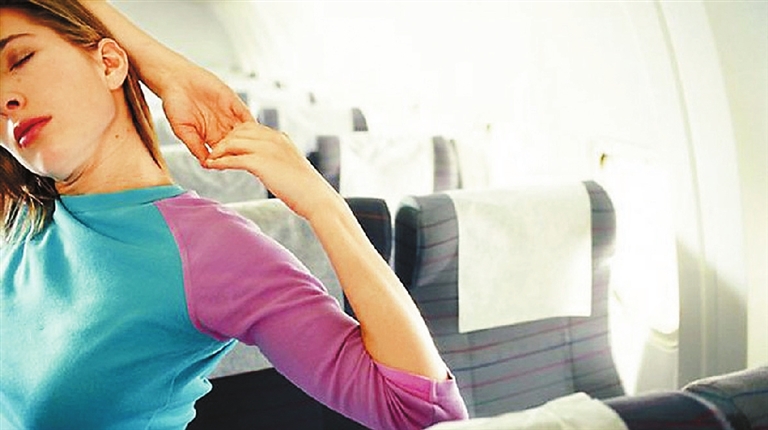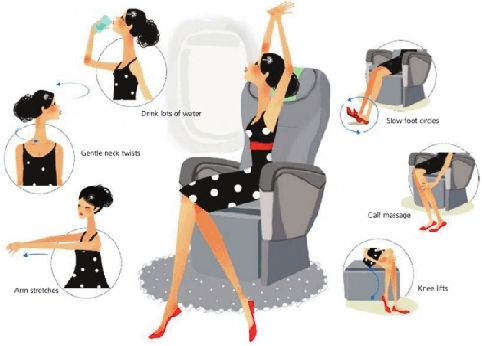


IT’S almost that time of year when you load up the car and road trip it to your favorite beach town or pack that carry-on and jet-set to a beautiful locale for a relaxing summer break. We know that putting up that out of office reply and taking a much needed vacation is good for our health. What isn’t so healthy? The hours spent sitting, cramped in the passenger seat or the economy cabin trying to get to your destination. The major risk that comes with sitting for prolonged periods of time — whether it’s in a car or on a plane — is stiffness in joints and muscles and stagnation of fluids, according to Dr. Karena Wu, celebrity physical therapist and owner of ActiveCare Physical Therapy in New York City and Mumbai. You may not be able to avoid that long flight or hours in the car, but you can make some adjustments to the way you’re sitting — and have some exercises on hand that will help reduce the impact on your body. Waiting in a line When it comes to flying, the hazards start when you arrive at the airport and get in the security line. Wu recommends making a few adjustments while you wait to get through security. First and foremost, put down those heavy bags. When you do pick them up to move in line, turn it into an exercise session with these moves: While holding bags, correct your posture, pull your abdominals in and stand equally on both feet, contracting the quads. “I see people standing with their backpack or purse/tote on one shoulder, and their hip jutting out to the side as they bear all of that weight on one side of the body. It’s not great for the low back or the shoulder girdle because you are compressing one side of the body,” Wu said. “People also slouch as they wait. So stand upright and use your own musculature to hold yourself erect.” When the line moves, turn it into a squat to lift the weight, or a straight leg move to slide your items forward and exercise the hip musculature. On the plane Once you board your flight, the main concern becomes stiffness in the joints from being in the seated position for an extended period of time. “Sometimes you can get neck and low back pain from when people fall asleep with their head in a severely bent position or when they continuously cross their legs and lean on an armrest,” she said. “It torques the back and bends it where you compress one side and overstretch the other.” The best thing to do is move. It forces you to contract and relax your muscles so that any fluids do not get stagnant and gives you a little exercise at the same time. You can also try in-seat exercises. “Exercises like ankle circles/pumps, knee extension (straightening the knees) and glute squeezes (squeezing your butt cheeks together) can help pump the muscles and give them a little workout at the same time,” she said. “For triceps, bring the arm overhead, bend the elbow and then pull the elbow to the side; for the back of the shoulder, bring the arm across the body and pull it across further with the other arm; and for the abdominals, reach both arms straight overhead and stretch up and back,” Wu said. She also recommends getting up and walking around the plane. She suggests once an hour as a good time frame to get up to stretch your legs (without irritating your fellow passengers). On a long road trip You will run into similar problems when sitting in the car for a long trip — in addition to stiffness in joints and the potential to fall asleep in an awkward neck position, where you put your feet can also pose issues. “In cars, there is a little more space so sometimes people sit on their feet or put their feet up which rounds the lower back,” Wu said. “That can cause disc-related pain as the flexed position is not healthy for the spine.” Do not sit with your legs tucked under you or up on the seat. This squishes the soft tissue in the knee/hip area and shortens the muscle. Get out and move around every hour. “Just like with sitting at a computer, it is recommended to stop and get out of the car every hour,” she said. “You can do 10 backward bends by placing the hands on the hips and moving the head and shoulders backward behind the pelvis to counteract the poor sitting posture.” Use cruise control. This frees you up to do some toe curls/splay stretching, ankle pumps/circles, glute squeezes, and abdominal bracing all when sitting, however use caution as attention should be paid on driving and not the exercises. “Stop crossing your legs,” Wu urges travelers. “It torques the spine, cuts off blood flow to the legs and facilitates muscle imbalances. It also leads to a rounded lower back as people have a tendency to slouch down when they cross their legs.”(SD-Agencies) | 
